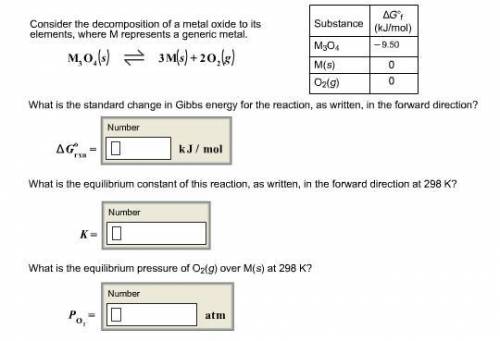
Chemistry, 08.04.2020 21:39 audjwood67
Consider the decomposition of a metal oxide to its elements, where M represents a generic metal. M 3 O 4 ( s ) − ⇀ ↽ − 3 M ( s ) + 2 O 2 ( g ) What is the standard change in Gibbs energy for the reaction, as written, in the forward direction? Δ G ∘ rxn = kJ/mol What is the equilibrium constant of this reaction, as written, in the forward direction at 298 K? K = What is the equilibrium pressure of O2(g) over M(s) at 298 K?

Answers: 2


Another question on Chemistry

Chemistry, 22.06.2019 17:30
98 points you will be galileo perform the experiment to determine if objects with different mass fall at the same, or different, rates in the air and in a vacuum. before you conduct your experiment, you need to form a hypothesis. a hypothesis is a prediction of what you think will happen in the experiment. the hypothesis is a statement that describes “if” a certain set of circumstances are present “then” there will be a specific result that will occur. record your hypothesis here: record the results from step one of the experiment (dropping the objects in the air): first trial: second trial: third trial: record the results from step two of the experiment (dropping the objects in a vacuum): first trial: second trial: third trial: did the experiment support your hypothesis? using the data from your experiment, describe why you believe your hypothesis was either proven or disproven. what forces were acting on the objects dropped in the air? what force was acting on the objects dropped in the vacuum? part two: comparing forces choose two forces and compare and contrast these forces. you must provide two ways that they are alike and two ways that they are different. you may make a list, write in paragraph form, or make a chart. choose two forces and compare and contrast these forces. these must be different forces than used in the prior question. provide two ways that they are similar and two ways that they are different. you may make a list, write it out, or make a chart.
Answers: 3

Chemistry, 22.06.2019 18:30
Asample of hydrated tin (ii) chloride (sncl2) has a mass of 4.90 g. when it is dehydrated, it has a mass of 4.10 g. which is the correct chemical formula for the hydrate? sncl2•2h2o sncl2•4h2o sncl2•6h2o
Answers: 2

Chemistry, 23.06.2019 01:30
What is produced from neutralization of an acid and a base? a. hydronium ions b. citric acid c. salt and water
Answers: 1

Chemistry, 23.06.2019 09:20
Description: biological systems 5 differ from chemical systems when it comes to equilibrium. in a chemical system once equilibrium is met, no other reactions occur. in a biological system, a dynamic equilibrium is used when a substrate is turned into a product, another reaction creates the same substrate thus keeping the concentrations stagnant. this allows for cells to continually make new compounds without messing the delta g for the systems instructions: write a response to the following prompt and then respond to your peers. your individual response is due thursday at midnight (cst) your response to your peers is due saturday at midnight (cst) prompt: propose what would happen if a living cell all the sudden reached chemical equilibrium. also discuss the effects of build up of a particular substrate on a biological system. how would this affect overall delta g's?
Answers: 3
You know the right answer?
Consider the decomposition of a metal oxide to its elements, where M represents a generic metal. M 3...
Questions


Mathematics, 21.07.2019 08:00

Mathematics, 21.07.2019 08:00


History, 21.07.2019 08:00





World Languages, 21.07.2019 08:00

English, 21.07.2019 08:00


Mathematics, 21.07.2019 08:00

History, 21.07.2019 08:00


Health, 21.07.2019 08:00

Mathematics, 21.07.2019 08:00

Mathematics, 21.07.2019 08:00

Mathematics, 21.07.2019 08:00

Health, 21.07.2019 08:00



 .
.
![\Delta G^o=[n_{M(s)}\times \Delta G^0_{(M(s))}+n_{O_2(g)}\times \Delta G^0_{(O_2(g))}]-[n_{M_3O_4(s)}\times \Delta G^0_{(M_3O_4(s))}]](/tpl/images/0590/3061/56a28.png)
 = Gibbs energy of reaction = ?
= Gibbs energy of reaction = ?![\Delta G^o=[3mole\times (0kJ/mol)+2mole\times (0kJ/mol)]-[1mole\times (-9.50kJ/K.mol)]](/tpl/images/0590/3061/a6722.png)










